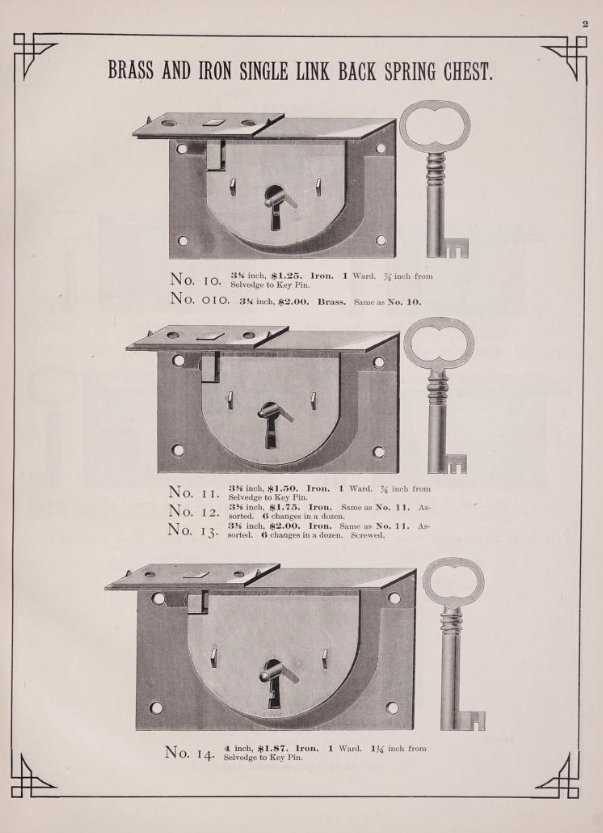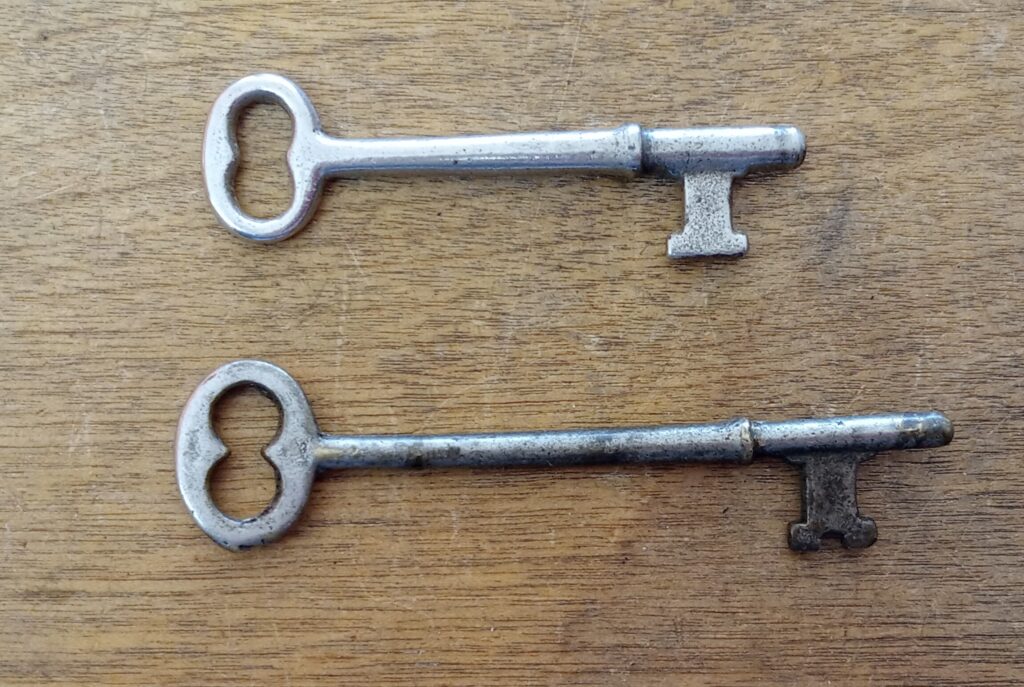When looking to match a skeleton key to one of your antique or vintage locks, the first thing to consider is what type of skeleton key you need. There are two major types of skeleton keys:
- Hollow barrel -which allows a pin inside the lock to be inserted into the end of the key. These types of keys are often a bit smaller and are typically used on trunks or furniture pieces. You should be able to see if there is a pin sticking out of the center of the lock hole.
- Solid barrel– these could be used on either furniture or door locks. There is no pin in the lock, just an open hole. The barrel of the key will be solid.
Next, if you can find a maker or brand on your lock that is great! It may help you find a key if the key is also branded. Don’t get hung up on this though. It is wonderful to have a matching branded key, but the most important thing about the key is the shape- not the brand. Historically just like today you had key companies and generic keys that were made for various locks. Also, a majority of keys (not to mention the hardware they went with) were not marked, so focusing more on the shape will give you far more options.
Furniture/Trunk Keys
For furniture keys there are a few things to consider once you figure out if you need a hollow barrel or not. First, the general size and shape of the key. Measure your keyhole. The size of these keys can vary quite a bit and if you know what will fit into your keyhole you can narrow down your options significantly. Some keys have bits (the extensions off the end) on both sides, most just on one. How long can the bit be? Also consider how long the key needs to be. Next, if you do need a hollow barrel, how large is the pin extending out of the lock? The barrel needs to be large enough to fit comfortably over the pin, but not too large that it does not fit into the keyhole. It also needs to be a long enough opening to fit fully over the pin to be able to reach the tumblers.
From here, unfortunately it is usually a matter of testing to find out what shape works. Before you begin testing, I recommend squirting a bit of WD40 or lock lubricant into your lock. You would be amazed at the difference this will make. If you find a key that moves the bolt a little, but doesn’t fully work, you are on the right track. Concentrate on keys with a similar shape to that with slight variants to find one that fully connects with the mechanism.
The most commonly used shapes I have found for furniture locks are the single edge notch and double edge notch as seen in this catalogue:

These two shapes are a good place to start. One of the two has a good chance of working. If these don’t work, you may need to move onto more complicated shapes.
Door Locks
Skeleton keys for door locks are a bit easier than furniture locks, as they will all have a solid barrel. However, minor size and shape variations can make a difference. First of all, make sure you are needing a skeleton key, not a flat key for your door lock. Skeleton keys need a large, open hole. You should be able to see through it. If possible, remove your lock from the door and inspect it. It is best to test unknown keys with the lock removed anyway in case they get stuck.
Check the outside of your lock box for any markings. These could be on the box, deadbolt, front plate, or inside the box itself. This may help you identify a maker. Sometimes, particularly if the marking is next to the keyhole, it may identify what key number you need. This only applies, however, if you can find a branded key matching your lock brand.
When you have the lock off the door, you might as well do some maintenance to make sure everything inside is good to go and functional. Check for any paint on the face where the latches are. If there is paint. at the very least take a razor blade and run it around the edges of the deadbolt, removing as much buildup from around the deadbolt as possible so that it can move freely. If you are brave enough to open the lock box up, use the screw or screws on the box part to remove the top of the box. Be very careful and move slowly, as sometimes things are under tension and you don’t want any parts to go flying. Before touching anything take a picture of the inside- this is important- you will never figure out where those pieces go if they get moved. There are thousands of variations of lock boxes and very little documentation on them, so be smart!
Once the lock is opened, manually try to manipulate the deadbolt. Does it move freely? If there is paint buildup, carefully remove the deadbolt part and clean all around the bolt and the edges of the hole until it can smoothly slide in and out. Now is a good time to clean up a little in there and add a little lubrication. Look for any markings inside to identify the lock and inspect the tumbler parts to see if you can gauge what shape key it might need. This is tricky, but you may be able to tell if it needs a notch or multiple notches. The more complicated the tumblers, the more complicated shape the key will be. Also see if there are any projections on the top or bottom of the box itself that may limit the movement of the key.
Carefully close up your lock and inspect the keyhole. Are there any small projections on the keyhole and how large is it? Projections will require either a groove along the key in that location or a very narrow key to fit between the projection. If the keyhole is larger, you will more likely need a beefier key with a larger bit. Keep the lock off the door while testing. If a key happens to get stuck, just loosen up the box cover and you can easily remove the key. Not so much if it is back on or in the door.
Just like furniture keys, there are two “generic” shapes of keys that have a good chance of working and are a good starting point. These tend to be the smallest in size and the most basic shapes. One of these two will have a good chance of working, or they can usually at least give you a good idea of whether you need a notch at the base of the bit or not.

The good news is that if you have all original locks, the key tended to be the same throughout most of the house. So once you find a key that works well- be sure to test on both sides- it should work on multiple locks.
